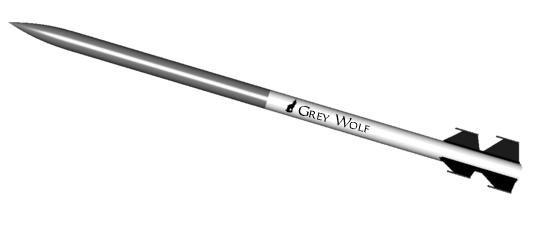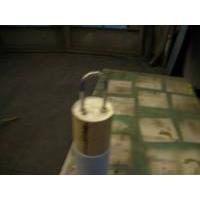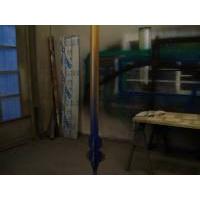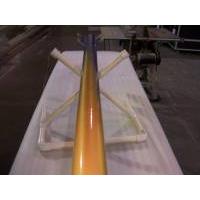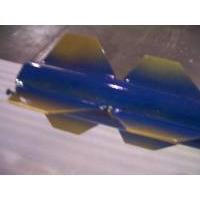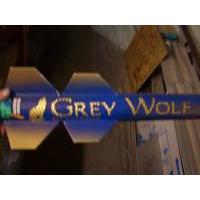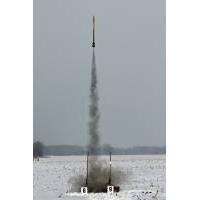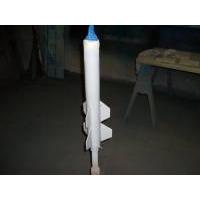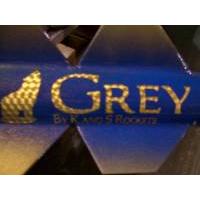| Construction Rating: | starstarstarstarstar |
| Flight Rating: | starstarstarstarstar |
| Overall Rating: | starstarstarstarstar |
| Published: | 2010-12-24 |
| Diameter: | 2.64 inches |
| Length: | 73.00 inches |
| Manufacturer: | K&S Rockets  |
| Style: | Sport |
Brief
|
|
The Grey Wolf's basic stats:
- Diameter: 2.64"
- Length: 73"
- Span Diameter: 8"
- Motor Mount: 38mm
Components

The Grey Wolf kit features Baltic Birch Plywood fins, bulkhead and centering ring, Tubular nylon recovery harnesses with sewn end loops, Nomex Fire Blankets, Rail Buttons, Plastic nose cone, heavy duty motor and body tubes, and vinyl decals. Instructions and a Rocksim file on CD are included with the kit. It does not come with parachutes, motor retention, charge cannisters, terminals, D-links, electronics. and the usual array of building supplies.
The harnesses and Nomex are high quality. The array of fasteners included with the kit are adequate for performance. I made substitutions based only on personal preference in building this kit.
Construction
K & S does a very detailed job on providing instructions. The only drawback is from the technical side, the instructions come on a CD. But. I had no problems with the files provided and printed them for my own use during assembly and to provide for a good place for notes or points of modfification.
Going into a kit like this it would be a good idea to have had at least some experience with the techniques involved in building a high power rocket kit. If you are not familiar with them, K & S has done a good job of detailing the processes with text and pictures (lots of them) involved in the assembly. Scott is also very personable and supports his products. He receives an A+ from me when it comes to customer service.
I started by inspecting the parts and components then printing the instructions. Then I read the instructions completely before beginning assembly (probably the biggest mistake newcomers make going into a high power build is to start without having read all the instructions).
Onward! Smell the epoxy!
The instructions are well thought out and detailed with plenty of photos - did I mention 27 pages worth?! There are only a few modifications to the build that I would recommend to the newcomer in high power rocketry - or at least a few things to point out to them before hand. I will footnote some of these modifications in lieu of documenting the entire build here.
The beginning of the assembly will start with marking and cutting the fin slots on the booster.
1. Fin slots. You will have to cut your own slots in the BT. If you haven't done this before be careful, cut away from your body or parallel to it, use a small piece of angle as a guide, use a sharp hobby/olfa knife, repeat use a sharp knife and be patient. This will take a few passes but is simple. If you are a newbie...This is probably the hardest part of the build you will encounter.
(Regarding the fins themselves later...I choose not to use the dowels on the fins just a personal preference but I digress!)
After slots are cut you will start assembling the motor tube. Couple things here: make sure you always scuff all paper components to assist your adhesives this may even include removing the outer layer and dry fit all componentes and check positioning before epoxy app. I tend to use 5 minute epoxies on all my builds as I work very quickly. I do not recommend this to most folks. Give yourself the time and go with a slower set.
2. Retention. Determine your motor retention means at the beginning of the build and make the modifications before you insert your mmt into the booster. I use thread inserts for #10 hardware. Some prefer to add Aeropack reatiners but just the good old fashioned "Kaplow" clone works fine for me.
3. The rail buttons. Do not install the rail buttons to the airframe until after you have done your finish/paint. Pre drill them as instructed and insert a small mandrel or toothpick in the holes prior to finishing.
Next you will be prompted for fin attachment. The instructions here are well thought out and detailed with many pictures. Take your time and this will be a piece of cake.
Next will be the tube coupler. Instructions here are fine and simple. This is where my hardware will differ from that supplied in the kit. I use Ubolts exclusively in my High Power builds on my bulkplates.
*Remember* This is a zipperless design, the instructions will not prompt you to drill holes in case you decide to use motor ejection at all or for backup. After the epoxy set, I drilled 6- .250" holes to allow for ejection gas to seperate the booster as a backup to my electronics.
4. The Ebay. The supplied eye bolts will work well for this kit but I opt for U bolts again. As the instructions state, know is the time to at least plan on your terminal types and charge canisters. The ebay assembly is a snap. When you go to put your inserts in for the bolts follow the instructions. I deviated from the instructions and flipped the orientation for redundancy and personal preference again. If you decide to do so, do not pull or push the spikes completely through the coupler tube. Be careful not to get epoxy in the threads. You will have to file a little bit off when complete. Make sure you make some reference lines on the inside of the tubes and on the couplers for re assembly. Again, you will have some holes and mounts that you will want to insert toothpicks or whatever in to keep the paint out while finishing. I drilled a .50" hole centered for the switch to be added later and 2- .250" vents for the altimeter.
I personally use 2 pole rotary style switches purchased from Missile Works (www.missileworks.com). I use standard terminal type blocks purchased from one of my electrical distributors, but can be found at Radio Shack or the like. I use charge canisters from Aerocon Systems (www.aeroconsystems.com) and make my own e matches out of supplies from Quickburst (www.quickburst.net)
The nosecone. This is another thing that may be new to someone out there. Follow the instructions! Do not use the OEM attachment point on a nosecone! The instructions lay out a good technique for supplying a solid anchor point. This is where I did use the supplied eyebolt, I just added a tack weld to prevent failure of the eyelet.
If you made it this far... The instructions will steer you towards paint prep and finishing then onto final assembly.
The portion of the instructions for final assembly of the harnesses and their attachment is a fine thought out progression detailed with pictures. These components are nice and after building this kit I am sure to buy recovery items in the future from K & S.
All in all construction, instructions and components provided.... I give this a solid, and I mean solid, 4.75. The only reason I do not go a 5? Addressing some of the potential issues as detailed above in the instructions for someone newer to this type of build.
Finishing
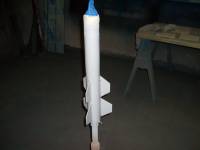 Finishing...Oh boy!
Finishing...Oh boy!
This is one of my deepest loves in the hobby.
As far as prepping? If you took your time on this kit the prep work is easy. I sand everything down with a 220 grit, use toothpicks or spent rivet mandrels off my floor to fill the pre drilled holes for my fastening hardware and rail buttons, tack it off and start priming. I use a full blown commercial system to paint so some of what I describe is going to unfamiliar ground to some.
Most of my work is done with MAP paints meaning, Matthews Acrylic Polyurethane. (www.ppg.com/coatings/matthewspaint/pages/default.aspx) They are tough and what can I say....An industry standard for me in the custom fabrication, architectural and signage world.
For priming I use their fillsetting type of Polyester primer. This builds quick, dries fast and sands within an hour. This is almost the equivalent of adding glass to an airframe. If I added a 'sock' to the tubes, I am sure it would have the same effect. On this build I chose to use some ND, go Irish Hockey that is!, colors I had laying around. I went with a solid blue color and worked 2 different tones of gold flake up and down the tube. The supplied vinyl decal would not look good with the color combination so I asked Scott if I could get the file so I could recut it out of a different material. He put me in touch with Mark from Stickershock, another grade A+ customer service vendor, and the file was on its way! I cut the logo originally provided out of a hand turned goldleaf and applied it. 3 coats of gloss clear later to seal everyhting up and give it a nice shine and.... Done!
Construction Score: 5
Flight
Maiden flight
12/18/2010
Michiana Rocketry
Three Oaks, Michigan
This was a blustery cold day, ceiling was at times obstructed with lake effect snow squalls throughout most of the day. I prepped the rocket, installed my RRC2 mini and started on the quick build of a Kosdon 38/390 I300 fast propellant load. I probably should have waited for the nicer clear skies we encountered later but in our area you never know what is going to happen so off to the pad she went. Flight was a rip off the pad and straight up into a upper level squall. We lost sight as she entered but luckily heard the first event and everyone started panning their view and listening for event 2. Event 2 occured and we picked her up gently coming downrange into another field. No damage, nice straight true flight and about where the sim predicted.
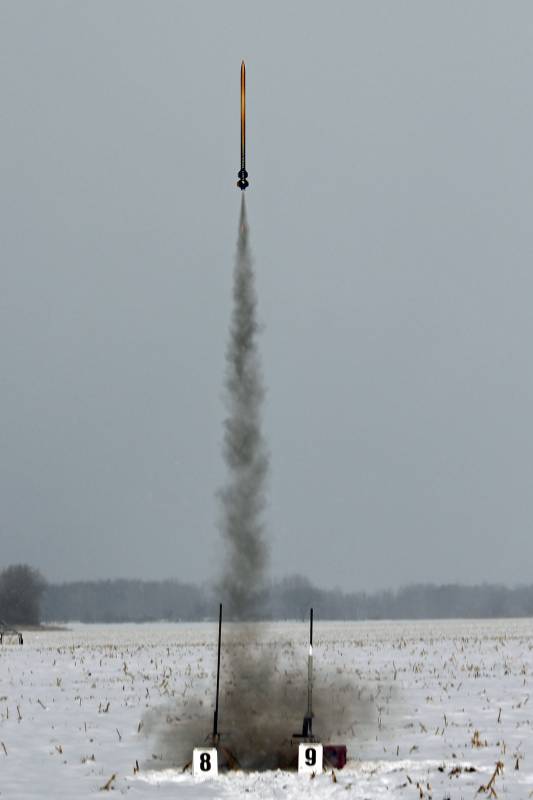
My finished kit was heavy compared to the estimate due to my building techniques, hardware changes and my paint/clear job as usual.
- 76"length
- 79 ounce weight on the pad.
- 3792' by altimeter
- 12 seconds to apogee
- Peak velocity 781 fps (532.38 mph)
The flight video can be seen here...
http://www.youtube.com/watch?v=pUVUB6FKkFM
Recovery
The recovery harnesses and Nomex supplied is top notch. I used some of my old chutes on the flight that performed well. My next flight I will probably go drogueless and opt for a 36" chute for a main.
Summary
As a whole this was a quick build for me, the parts are complete and sufficient, the instructions are detailed and easy to follow, the recovery components supplied are very high quality and rare to receive with a kit like this.
This kit out of the box gets a solid 'A' from me. If you are new to this type of build you will definitely learn a few solid techniques from it. And again...Good luck purchasing a kit from another vendor that will come with high quality recovery components as this and from one you will receive this level of customer service if needed!
 |
 |
